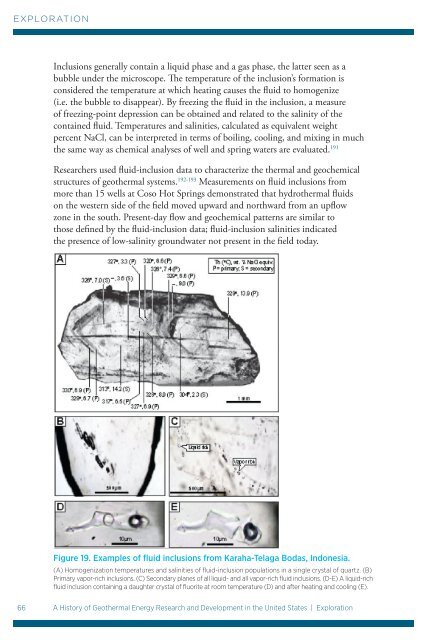A History of Geothermal Energy Research and Development in the ...
A History of Geothermal Energy Research and Development in the ...
A History of Geothermal Energy Research and Development in the ...
Create successful ePaper yourself
Turn your PDF publications into a flip-book with our unique Google optimized e-Paper software.
EXPLORATION<br />
Inclusions generally conta<strong>in</strong> a liquid phase <strong>and</strong> a gas phase, <strong>the</strong> latter seen as a<br />
bubble under <strong>the</strong> microscope. The temperature <strong>of</strong> <strong>the</strong> <strong>in</strong>clusion’s formation is<br />
considered <strong>the</strong> temperature at which heat<strong>in</strong>g causes <strong>the</strong> fluid to homogenize<br />
(i.e. <strong>the</strong> bubble to disappear). By freez<strong>in</strong>g <strong>the</strong> fluid <strong>in</strong> <strong>the</strong> <strong>in</strong>clusion, a measure<br />
<strong>of</strong> freez<strong>in</strong>g-po<strong>in</strong>t depression can be obta<strong>in</strong>ed <strong>and</strong> related to <strong>the</strong> sal<strong>in</strong>ity <strong>of</strong> <strong>the</strong><br />
conta<strong>in</strong>ed fluid. Temperatures <strong>and</strong> sal<strong>in</strong>ities, calculated as equivalent weight<br />
percent NaCl, can be <strong>in</strong>terpreted <strong>in</strong> terms <strong>of</strong> boil<strong>in</strong>g, cool<strong>in</strong>g, <strong>and</strong> mix<strong>in</strong>g <strong>in</strong> much<br />
<strong>the</strong> same way as chemical analyses <strong>of</strong> well <strong>and</strong> spr<strong>in</strong>g waters are evaluated. 191<br />
<strong>Research</strong>ers used fluid-<strong>in</strong>clusion data to characterize <strong>the</strong> <strong>the</strong>rmal <strong>and</strong> geochemical<br />
structures <strong>of</strong> geo<strong>the</strong>rmal systems. 192-193 Measurements on fluid <strong>in</strong>clusions from<br />
more than 15 wells at Coso Hot Spr<strong>in</strong>gs demonstrated that hydro<strong>the</strong>rmal fluids<br />
on <strong>the</strong> western side <strong>of</strong> <strong>the</strong> field moved upward <strong>and</strong> northward from an upflow<br />
zone <strong>in</strong> <strong>the</strong> south. Present-day flow <strong>and</strong> geochemical patterns are similar to<br />
those def<strong>in</strong>ed by <strong>the</strong> fluid-<strong>in</strong>clusion data; fluid-<strong>in</strong>clusion sal<strong>in</strong>ities <strong>in</strong>dicated<br />
<strong>the</strong> presence <strong>of</strong> low-sal<strong>in</strong>ity groundwater not present <strong>in</strong> <strong>the</strong> field today.<br />
Figure 19. Examples <strong>of</strong> fluid <strong>in</strong>clusions from Karaha-Telaga Bodas, Indonesia.<br />
(A) Homogenization temperatures <strong>and</strong> sal<strong>in</strong>ities <strong>of</strong> fluid-<strong>in</strong>clusion populations <strong>in</strong> a s<strong>in</strong>gle crystal <strong>of</strong> quartz. (B)<br />
Primary vapor-rich <strong>in</strong>clusions. (C) Secondary planes <strong>of</strong> all liquid- <strong>and</strong> all vapor-rich fluid <strong>in</strong>clusions. (D-E) A liquid-rich<br />
fluid <strong>in</strong>clusion conta<strong>in</strong><strong>in</strong>g a daughter crystal <strong>of</strong> fluorite at room temperature (D) <strong>and</strong> after heat<strong>in</strong>g <strong>and</strong> cool<strong>in</strong>g (E).<br />
66 A <strong>History</strong> <strong>of</strong> <strong>Geo<strong>the</strong>rmal</strong> <strong>Energy</strong> <strong>Research</strong> <strong>and</strong> <strong>Development</strong> <strong>in</strong> <strong>the</strong> United States | Exploration

















